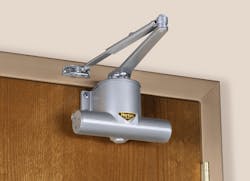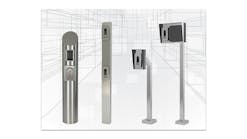You are contacted by a customer or your employer to look at a commercial/institutional door you have not seen before. There seems to be an undetermined problem with the door closer. Not an uncommon request; however, there is no way of knowing the brand or type of door closer without going to the door and inspecting.
We know there are four styles of commercial door closers: surface mounted, concealed in the frame, in-floor (concealed) and concealed in the door. The likelihood is the door closer will be a surface mount on a hollow metal or wood door.
The surface mounted door closer has had significant changes in the last 70 or so years since the change from a "pot belly" style of door closer. Some of the changes include aluminum body, all weather fluid, powder coated finishes, adjustable back check, delayed action, cam closers and special function arms including the track arm.
A significant change has been the development of the power adjustable door closers, which permit the spring power to be increased or decreased in an attempt to meet the needs of the opening. Power adjustable door closers range from the general operation of 1-6, to the higher end models for larger, heavier doors such as 5-7. An important application for power adjustable door closers is to meet the barrier free operation to comply with Federal Accessibility Standards (ADA) complying with ANSI 117.1 for under five pounds opening force.
In North America, most modern surface mounted door closers use a rack and pinion mechanism designed with a spring(s) to give power to close the door and hydraulics to control the speed of the door. As the door is opened, the pinion rotates, forcing the rack to move and compress the spring(s) storing energy to close the door.
To control the movement of the door, hydraulic fluid moves through the door closer body through a series of channels and valves. The two most important valves are sweep speed valve and latch speed valve. When the door is released (from a maximum of 180 degrees), the door begins the closing procedure. The sweep speed valve controls the fluid movement from the opened position to about 10 to 15 degrees (approximately 8") from the closed position. At this point, the latch speed valve controls the door speed into the door opening and the lock latches.
The term ‘door closer’ is actually a misnomer. Although door closers close the door, they actually operate as door controllers, controlling the opening and closing operations. Even if a door closer is not equipped with backcheck, fluid is forced through the closer body affecting the opening speed of the door.
The surface mounted is the easiest door closer to install. Upwards of four screws secure the closer body and up to five screws secure the arm bracket. Because this type of door closer is not concealed, minimum modification or brackets are needed for the installation.
Surface mounted door closers are available in four basic variations: track arm, regular arm, parallel arm and top jamb mounted.
The regular arm door closer is mounted on the upper portion (top rail) of the pull (hinge) side of the door. The arm is attached to the frame face at a right angle to the door.
The parallel arm door closer is mounted onto the push side (opposite the hinge) side of the door and the arm mounted onto the head jamb. The arm is parallel to the door, unlike the regular arm that is at a right angle to the door.
The top jamb door closer is mounted onto the push side (opposite the hinge side) head jamb. The arm is attached to the upper portion (top rail) of the push (opposite the hinge) side of the door at a right angle to the door.
The track arm door closer is mounted on either the push side or pull side of the door. When track arm closer body is mounted onto the push side of the door, the arm is mounted onto the head jamb. When the track arm closer body is mounted onto the jamb head, the track is mounted onto the upper portion of the push side of the door. When track arm closer body is mounted onto the pull side of the door, the arm is mounted onto the frame face. When the track arm closer body is mounted onto the jamb head, the track is mounted onto the upper portion of the pull side of the door.
Surface mounted door closer mountings have advantages and disadvantages. The top rail mounted closer arm is mount onto the frame face, which means a narrow frame face does not cause any problems. The top rail mounted closer arm projects from the door at approximately a right angle. This position is easily assessable to vandalism. However, the geometry of the regular arm closer is somewhat more power efficient than a parallel arm closer.
The top jamb mounted door closer is mounted onto the frame face, which can be advantageous for narrow stile aluminum glass doors with small top rails. The geometry of the top jamb closer is somewhat more power efficient than a parallel arm closer.
The parallel arm closer's forearm is mounted to the underside of the frame head using a soffit plate. The arm is relatively protected, being parallel to the door. It does not extend out like the regular arm or top jamb closers. However, the geometry of the parallel arm closer is somewhat less power efficient than a regular arm or top jamb closer.
The track arm (slide channel) closer has even more protection against vandalism, as the track, which is mounted onto the jamb, operates as the forearm. The geometry of the track arm reduces door closer power efficiency similar to that of a parallel arm. However, to compensate, door closer manufacturers developed the cam action door closer.
The cam action door closer has a linear drive mechanism with a heart-shaped cam. The cam's shape provides lower opening resistance, while providing more favorable control and closing force. A cam action door closer with a track arm application can provide efficiency similar to a rack and pinion door closer in a regular arm application.
The Corbin Russwin DC5000 Series, Norton 2800ST and Sargent 421 Series cam action door closers are designed for doors with an interior width up to 54", weighing a maximum of 250 pounds. These cam action door closers have adjustable spring size from 1 to 6 to accommodate five pounds closing force.
The DORMA TS 93 cam action, surface mount door closer is designed for doors up to 50 inches wide. There are two closing force options, either 2-5 or 5-7. An additional option includes a smoke detector integrated into the slide channel. The smoke detector is designed to release the door closing mechanism when smoke is detected.
Surface mounted door closer capabilities has been expanded to include being a multi-point elecromechanical closer/holder that keeps a door open to any point up to 180 degrees depending upon the installation. These closer/holders can be ordered with integral smoke detectors or remote wireless releases.
The Norton 7100SZ Series SafeZone incorporates a multi-point electromechanical closer and a programmable motion sensor. When the door is opened, the SafeZone will sense movement in the door opening from either direction. . The sensing area is size and sensitivity adjustable. When movement is sensed, the 7100SZ stops the door from closing. When movement is no longer detected, the door closes. Setting times are adjustable to compensate for the age and ability of people using the door.
The handed, SafeZone can be installed onto the push or pull side of the door. The options include dual sensors and select hold open. Having a door closer that can identify movement can reduce the damage to doors and frames by carts, equipment, wheelchairs or gurneys.
Making use of technology in a different direction, the LCN 4210 Smoothee Series is a heavy duty, high security closer with specialized components and fasteners to limit tampering and/or vandalism. The forged steel parallel arms and heavy gauge metal security covers are designed for vandal prone, institutional and other high traffic applications.
The types and styles of surface mount door closers have expanded by both the major lock manufacturers and the aftermarket importers. Door closers have not only increased longevity, but manufacturers have increased their warranties.
As a final note, always write the date of installation onto either the inside cover or the body of the closer. This way, should the door closer begin to leak or not operate properly, you know the length of time the closer has been on the door. A number of door closer manufacturers offer warranties in excess of 20 years.
For More Information
The door closer manufacturers discussed in this article include:
- Corbin Russwin: www.corbinrusswin.com/
- DORMA: www.dorma.com/us
- LCN: us.allegion.com
- Norton: www.nortondoorcontrols.com
- Sargent Lock: www.sargentlock.com






